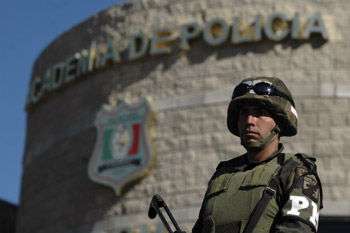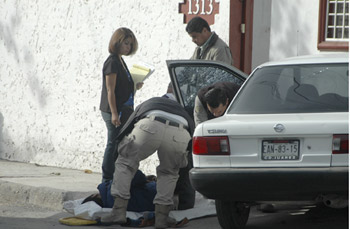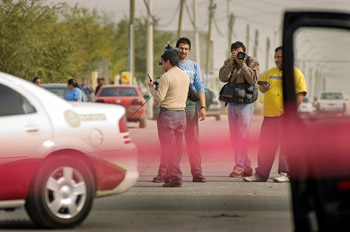In one of Mexico’s most dangerous cities, reporting the news requires extreme caution. Self-censorship and manipulation of the news are constants. By Mike O’Connor
CIUDAD JUÁREZ, Mexico
It was just after 1:30 p.m. on May 27 and Luz Sosa, a police reporter for El Diario newspaper, was leaving the office of the state attorney general while doing her rounds in Ciudad Juárez. Her photographer, Julio Aguilar, got a cell phone call. He began moving quickly toward their car, motioning anxiously for her to follow. There had been another execution killing.

That alone made it dangerous for them. A year earlier, the two major drug cartels fighting to control Ciudad Juárez had broadcast over the police radio network that they would kill journalists who arrived at the scene of an execution while gang members were still present.
As the two journalists hurried to the crime scene, the danger increased. They learned the identity of the victim: He was the brother of the city treasurer. That meant he could have been killed for resisting efforts by one of the cartels to control local government. Reporters who develop information about that angle of a story can quickly become targets of a cartel themselves.
Sosa also realized the victim was a businessman from a prominent family, a possible target for extortion by one of the cartels, which operate with near impunity here. Journalists in Ciudad Juárez, a border city in the north-central state of Chihuahua, told CPJ that reporters who look into how extortion works or why the police don’t solve the crimes are at grave risk from the cartels, or from the police themselves.
• Versión en español
• Audio report
For the press, Ciudad Juárez is among the most dangerous cities in one of the deadliest countries in the world. CPJ research shows that 27 journalists have been killed in Mexico since 2000, at least 10 in direct reprisal for their work, and that seven more have disappeared. In November, veteran police reporter Armando Rodríguez was shot dead in front of his home in Ciudad Juárez. State investigators told CPJ they have identified drug cartel members as suspects in the killing, but federal authorities in charge of the case have not acted on the information. The federal attorney general’s office declined comment on the status of its probe.
Amid this culture of impunity, journalists in Ciudad Juárez say there is no reason any one of them might not be next on a cartel hit list. The violence and intimidation have caused lasting damage to the press corps here, as in other parts of Mexico. Even as the rate of killings ebbs and flows, self-censorship, skewed coverage, and manipulation of the news are constants. The federal government has touted its recent security gains in Ciudad Juárez, but it has a responsibility not merely to provide safety but to ensure basic human rights, including freedom of the press.
Self-censorship takes hold
The homicide victim that day was Oscar Urías. He lay under a maroon blanket on the sidewalk next to a black Ford pickup, its driver’s side window shot out. Local plainclothes police detectives were arriving, along with federal police in blue uniforms, bullet-resistant vests and assault rifles, and soldiers in green uniforms and helmets.
Not even the mayor of Ciudad Juárez trusts the city police to be uncorrupted by the drug cartels or to solve crimes, so the army and federal police are here essentially to supplant local officers until a new force can be recruited and trained. About 7,500 soldiers patrol the streets, putting up roadblocks to search cars, searching houses for weapons and drugs, and arresting alleged cartel members. A military officer now serves as police chief; others run sections of the police department and the city jail.
But people don’t trust the army all that much either, many journalists said. Since the new forces arrived in February, journalists said, cartel operations have continued as usual, except for a brief truce in murders. “The military arrests a few hundred street dealers,” Sosa said. “But that doesn’t change anything. Where are the arrests of the cartel leaders? What about the financiers who launder the money? Or the politicians who are involved? The army doesn’t know how to investigate crimes. They were never trained for that.”
Evidence that journalists still consider it too dangerous to cover many stories was apparent at the scene of the murder, which, considering who the victim was, should have been a big story. Only seven journalists were present, although the city, with a population of about 1.5 million, has many news organizations.

One of the major newspapers is Norte de Ciudad Juárez, which has a strict policy of not publishing information about anything that could possibly be associated with the two cartels that wield so much power. Norte’s small story about the murder, which appeared on Page 6, came from the scant facts contained in a brief police report: the name of the victim, the number of wounds, the caliber of the weapon, the fact that 10 shell casings had been found. The story did not even note that the victim was the cousin of the newspaper’s owner.
“We have learned the lesson: To survive, we publish the minimum,” said Norte Editor-in-Chief Alfredo Quijano, referring to self-censorship practices adopted after Rodríguez’s slaying last fall. “We don’t investigate. Even at that, most of what we know stays in the reporter’s notebook.” This at a time, Quijano said, when cartel money flows easily into local political campaigns, when police are bought off or scared off from investigating, and when the cartels are expanding into kidnapping and extortion.
Being a probing reporter these days is too dangerous, he said. “Yes, you can do journalism. You can investigate. Then you can publish. But then you have to leave the country quickly.”
El Diario played the killing differently. Sosa’s long story ran at the top of the front page and quoted people close to the victim’s family as saying he had received threatening phone calls in which extortion money was demanded. Dangerously, Sosa’s story blamed the cartels for the killing.
But El Diario staff is aware of the limits, too. Five days before the murder, Sosa’s newspaper was reminded of how little the cartels will tolerate. The paper’s bureau in the city of Hidalgo del Parral in southern Chihuahua ran across a story about money laundering, and El Diario thought it could be just a little bit bold. Looking back, editors think they made three mistakes.
The paper’s first story identified the drug cartel alleged to be involved. It was the Sinaloa cartel, the one battling the Juárez gang over control of Ciudad Juárez. And it named the cartel’s leader in the area. In a second story, the paper named the banks allegedly involved in the money laundering: one in El Paso, across the border in Texas, and the other in Los Angeles. Then they got the threatening phone call. They had a third story ready to go, but they didn’t publish it. Instead, they closed their office in Hidalgo del Parral, and the staff went into hiding.
“We were very cautious,” said Pedro Torres, a senior editor. “We published only a small part of what we knew. We tried a small investigation, and right away they got back at us.”
A death’s ripple effect

Armando Rodríguez, the reporter killed in November, had gotten a death threat by phone months earlier. According to journalists in Ciudad Juárez, he had complained to state Attorney General Patricia González Rodríguez, who directs investigations of state crimes, but she told him she could not protect him. (The attorney general’s office denied such an exchange had taken place.) Colleagues said he reviewed all his recent news stories and found nothing he could connect to the threat.
Being careful in what you publish helps, said Sosa, a 39-year-old mother of two who took Rodríguez’s place on El Diario’s crime beat. “But that may not be enough if the reporter starts to ask delicate questions,” she said, “because the criminals may kill you not for what you publish, but for what they think you know.” Days before he was murdered, Rodríguez published an article linking the nephew of the attorney general to narcotics traffickers.
What happened to Rodríguez was felt by journalists across the city. It was felt they were all vulnerable, and, as the investigation dragged on without progress, it seemed the killers would not be caught. Journalists were fair game. After Rodríguez’s murder, news organizations developed policies to limit exposure. Most no longer use bylines in crime stories. In trying to placate the cartels, some tone down their language, using, for example, “armed men” rather than “gunmen.” Some will not identify a cartel believed to be responsible for a murder unless a government official goes on the record naming the gang. Others, like Norte, simply report the barest of facts. Many journalists in Ciudad Juárez said a local TV station moved operations for a time to El Paso after employees received death threats. Executives at the station would not comment.
A near-complete breakdown in police investigations in Ciudad Juárez means that any threat against a journalist must be taken very seriously—because any attack against a journalist will almost certainly go unpunished. El Diario reported in May that only 2.7 percent of murder cases in 2009 had been solved. Another El Diario article reported that each homicide investigator was working on up to 130 cases. Not even the murders of law enforcement officers are solved, according to records kept by El Diario. Seventy-one were killed last year and 31 this year; none of the cases were solved.
Last year there were 1,607 murders in Ciudad Juárez, most of them cartel hits, the newspaper said. After the army vastly increased the size of its forces in February, the number went down dramatically, but it is rising again. In the last two days of May alone, there were 34 murders.
The press in Ciudad Juárez is not only restricted by the cartels, it is manipulated by them. Edgar Román, news director of Channel 44, said organized crime groups are timing murders in order to get live coverage on the evening news. “They are killing for my newscast,” he said. “Either 10 minutes before or while we are on the air.” Journalists said cartels want the people of Ciudad Juárez to be afraid, so they want pictures of cartel enemies dead on live TV. One cartel wants to look more menacing than the other so it wants its threatening messages featured.
Román recalled a night last winter when a message from a cartel was left written on a banner outside his TV station. The newscast covered it live but didn’t read it. Immediately, the station received a threatening phone call demanding the message be read. Fearful, the station paraphrased the message.
New cartel, new dangers
Adrián Ventura thinks he saw the first time the Sinaloa cartel make a move on the Juárez cartel. It was late winter of 2007. The Juárez group for many years had complete control of the drug route through Juárez into the United States as well as street sales in the city, said Ventura, who owns a news Web site and covers local crime in Ciudad Juárez. There were a lot of street sales of marijuana and cocaine to factory workers in north Juárez, he said. But the illegal trade was peaceful, the cartel controlled everything, he said, and the only time the police came around was at shift change to collect their daily bribes. Then, early one morning, he got a call that six or seven street salesmen had been shot with assault rifles. He went to the scene, and he still couldn’t believe it. “It couldn’t be, I thought. No one from here does that. We didn’t use those weapons. No one killed that many people,” he said.
“We knew it was a message, but we didn’t understand it.”
Very soon it was clear, as the number of dead increased and the cartel war got under way. The Sinaloa cartel was trying to take over the Juárez cartel’s home base. Today, in the traditional street sales areas like Barrio Alto and Alta Vista, the salesmen are gone. The people say it’s not because of the police or the army, but because no one wants to get caught up in the cartel feud, as the first victims had.

Ciudad Juárez is a special case, local journalists say, because it is a large city, a gateway for drugs to the United States, and a place where a single cartel had so penetrated local politics and police ranks that it got whatever it needed. Now that a second cartel is fighting to take over, the government’s weaknesses—its inherent corruption and incompetence—are exposed.
That only makes it an extreme example of many towns and cities in Mexico, where journalists fear drug cartels or government officials, and tailor what they write or broadcast.
In the capital of Michoacán state, Morelia, the owner of a major statewide news organization said that to stay safe from cartel retaliation, he imposes the same bare-bones reporting restrictions employed by most news organizations in Ciudad Juárez. In Acapulco, two years ago, a reporter was shot dead in the street by what many of his colleagues said was a cartel hit man. In April, the National Human Rights Commission ordered the government to provide bodyguards to a reporter who had been threatened by the powerful national secretary of public security. In May, a reporter in Durango state was abducted from his home, in front of his family, by eight men in ski masks. His body was found the next day. Banners from a drug cartel appeared around the city of Torreón, where he was buried, warning journalists to be careful, according to press accounts.
Two reporters have fled Chihuahua state for the United States in the past year. One, Emilio Gutiérrez, has applied for political asylum, and is waiting for a court hearing to see if it is granted. He said he had written articles that angered the Mexican army and that it had sent troops to threaten his life. He fled with his teenage son and was detained for seven months, but was released in January pending the hearing.
The other is Jorge Luis Aguirre. He ran a news Web site in Ciudad Juárez, covering crime and politics in a critical and sometimes mocking way. The night of Armando Rodríguez’s wake, a cell phone caller said Aguirre would be next. He fled immediately with his wife and three children to El Paso and said he intends to apply for asylum.
Aguirre has set up his Web site again. Recently, driving to a press conference, on a road next to the border, with Ciudad Juárez only a narrow river away, he spoke of the trouble of starting a life again at 51. But he looked over at Mexico and said, “I can’t go back. They’ll kill me.”
Mike O’Connor is CPJ’s representative in Mexico. He has been a reporter overseas for CBS News, National Public Radio, and The New York Times.